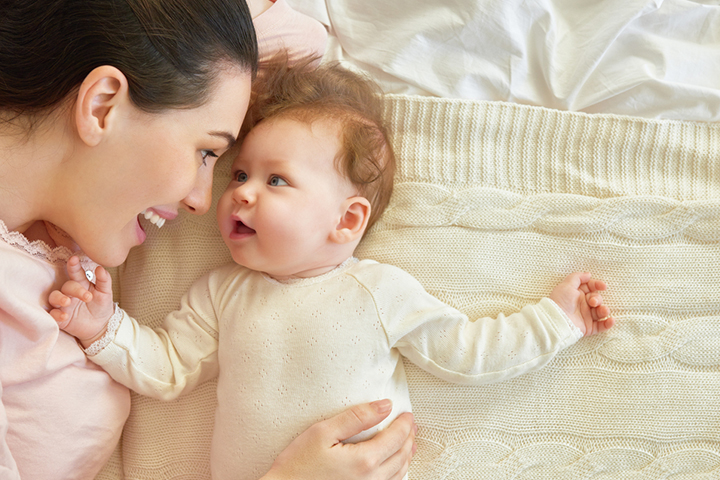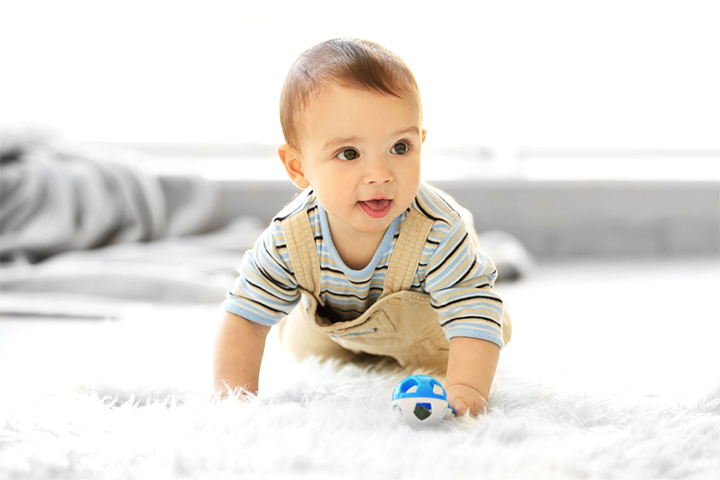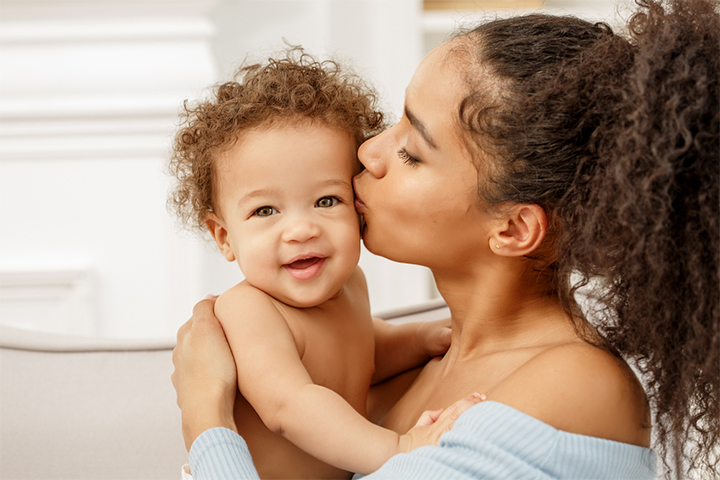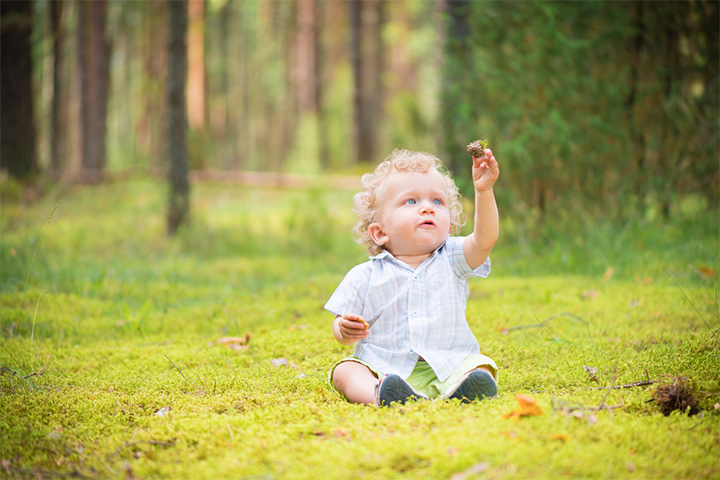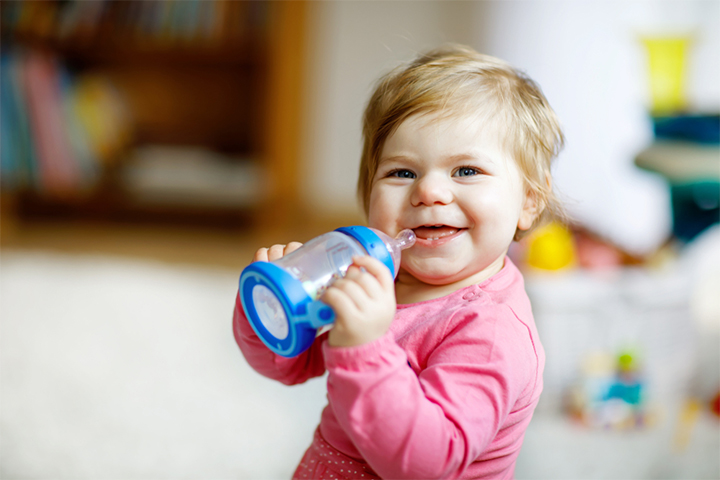
Image: Shutterstock
The prenatal brain development begins when a baby is still in the mother’s womb. By the time the baby is born, they already have around 100 billion neurons (1). A baby actively acquires new knowledge and develops vital skills using their senses in the first few months. So even when your baby seems to look like a potato who stares at blank walls, their brains are working much faster than yours. Here in this article, we have collected some of the most essential milestones your baby should reach in the first year of their life. Read on to know them all.
1st Month Milestones
Image: Shutterstock
Infants, by day one or two, develop skills like sucking, gripping, swallowing, and other primitive reflexes mature (2). The infant’s hand motions are quick and jerky as they clench their fists and try to touch their lips and eyes. While lying down, they can turn their heads. They respond with shock to unexpected and loud noises and may follow the rhythm & melodies of speech. They may also identify their mother’s voice and other familiar sounds.
2nd Month Milestones
Image: Shutterstock
Your infant looks at faces, turns their head when they hear a voice or other sound, and smiles back when they are smiled at. Their motions become more even and orderly. The infant can now push up when resting on their stomach and raise their head when lying off their back. Half as often as before, their palms are open, and their fingers aren’t squeezed into fists (2). A baby’s ability to grasp a rattle also increases around this period. Babies can suck their thumbs, identify their mothers, follow the movement of large, high-contrast objects, and open their mouths when they perceive breasts or a bottle.
3rd Month Milestones
Image: Shutterstock
Easy clenching and releasing of the fingers are now possible during the third month. Your infant frequently puts their hands in their mouth, reaches for things they can see, and shakes rattles they pick up. The infant starts to pay more attention and become more social around this time. They keep a watchful eye out for anything that could be moving and examine the faces of individuals around them. The infant may hum in response to the adult’s voice. By the time they’re 3 months old, some newborns have already begun to giggle (3) .
4th Month Milestones
Image: Shutterstock
The infant’s contagious grin mimics some of its caregivers’ gestures and emotions. They actively babble and imitate to recreate the noises they encounter. The infant develops more nuanced expressions of emotion, such as cries for hunger, discomfort, and exhaustion (4). They make their feelings known and display affection openly. By the fourth month, most babies can support their own heads, roll from their bellies to their backs, and sit up (with help).
5th Month Milestones
Image: Shutterstock
By the time they’re 5 months old, most babies can sit up with minimal support, use their hands to explore their environment, and bring items to their mouth (5). In addition, most babies can respond to their names and use non-crying noises to communicate displeasure.
6th Month Milestones
Image: Shutterstock
The infant can now roll from their belly to their back, shift their weight to one hand while lying down, and begin to sit up alone. The infant may now participate in a conversation by paying attention when an adult speaks to them and responding when they pause (6). And when they hear their name, they may respond with their own sound.
7th Month Milestones
Image: Shutterstock
There is an increase in stability when sitting unsupported. The infant can see colors clearly by the time he or she is 7 months old. They’re already excellent at spotting details in faraway objects and keeping tabs on those on the move (7). The infant responds to the sound of their own name and can also tell the difference between happy and sad voices.
8th Month Milestones
Image: Shutterstock
By this age, infants are attentive to their caregivers’ gaze and follow it when they turn away. This miniature human can also check for dropped items, express disapproval by shaking their head, locate familiar faces, and provide straightforward responses to inquiries like “Where is your mom?”
9th Month Milestones
Image: Shutterstock
Most children can imitate the sounds they hear, enunciate essential words like “mama,” and shake their hands when they’re asked to say goodbye by the time they are 9 months old. As an added bonus, kids can also choose items of interest with their fingers (8).
10th Month Milestones
Image: Shutterstock
The infant can crawl easily, navigate around furniture, and look beneath a blanket to uncover a concealed toy and watch the grownups. They respond to the words “Bye!” enthusiastically, waving their hands. By 10 months, some children can recognize both of their parents (by associating the term with the appropriate parent) and are beginning to understand simple requests like “give me the toy, please.”
11th Month Milestones
Image: Shutterstock
Your baby can now spin around while sitting and move around while hanging on to furnishings with one hand. This often occurs around the one-year mark. Many infants can now stand for brief periods and walk while clinging to a parent’s hand.
12 Month
Image: Shutterstock
By the time a child reaches the age of one, the infant is capable of self-sufficiency in several areas, including placing objects in a container, retrieving objects from a play box, using a cup, drinking from it, and combing their hair. They shake, hurl, and knock things about to see what happens. When given a name, the infant can recognize faces and place objects in a picture. They may pick up a pencil and scribble on paper, stack two blocks, and hand their parents a book to read if they desire to hear a tale.
Even though these milestones are generalized into time frames, babies sometimes take their sweet time to reach them. As long as your pediatrician is not worried about their development, you can keep all your anxieties away and watch your little one grow in front of your eyes every day.





